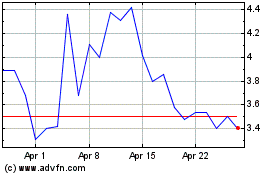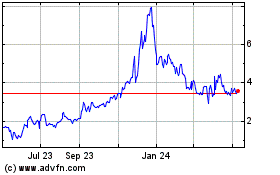Dermira, Inc. (NASDAQ: DERM), a biopharmaceutical company dedicated
to bringing biotech ingenuity to medical dermatology by delivering
differentiated, new therapies to the millions of people living with
chronic skin conditions, today presented data from a post-hoc
analysis of the Phase 3 open-label ARIDO study which evaluated the
long-term safety of glycopyrronium tosylate in patients with
primary axillary hyperhidrosis. The data showed the response of
pediatric patients (ages 9 to 16) compared to older patients (ages
17 years and older) with primary axillary hyperhidrosis who
received treatment with glycopyrronium tosylate (now QBREXZA™
(glycopyrronium) cloth). Compared to adult patients, pediatric
patients receiving glycopyrronium tosylate experienced similar
rates of improved disease severity and decreased sweat production,
and reported improved quality of life.
These data were presented in an oral presentation by Dr.
Lawrence Green today during the 27th European Academy of
Dermatology and Venereology (EADV) Congress in Paris, France.
Primary axillary hyperhidrosis, commonly known as excessive
underarm sweating, is a chronic medical skin condition that results
in sweating beyond what is needed for normal body temperature
regulation. The exact cause is unknown. It affects nearly 10
million people in the United States, and both men and women
similarly.
Glycopyrronium tosylate is a once-daily, topical anticholinergic
cloth designed to block sweat production by inhibiting the
receptors responsible for sweat gland activation.
“Primary axillary hyperhidrosis affects people of all ages, yet
there are few treatment options to address this condition,” said
Lawrence J. Green, M.D., associate clinical professor, Department
of Dermatology at George Washington University School of Medicine.
“The findings observed in the Phase 3 glycopyrronium tosylate
studies collectively demonstrate comparable rates of efficacy and
safety following treatment with the therapy in both adults and
children, giving us greater confidence that the therapy may provide
an effective treatment option for young sufferers of this often
embarrassing medical condition.”
Results from an analysis of pediatric patients from the Phase 3
ATMOS-1 and ATMOS-2 clinical trials were initially presented
earlier this year at the 76th Annual Meeting of the American
Academy of Dermatology. The new post-hoc analysis presented today
from the Phase 3 ARIDO study was designed to assess the long-term
safety of glycopyrronium tosylate in pediatric and adult patients
(ages 9 years and older) who participated in the ATMOS-1 and
ATMOS-2 studies, respectively. Pooled data evaluated pediatric
patients (ages 9 to 16) versus adult patients (ages 17 and older).
Patients who participated in ARIDO received up to an additional 44
weeks of treatment with glycopyrronium tosylate. Of the 44
pediatric patients randomized in ATMOS-1 and ATMOS-2, 43 completed
either trial and 38 entered ARIDO.
Key findings from the post-hoc analysis of ARIDO include:
- The median absolute decrease in sweat production at 44 weeks of
treatment for pediatric vs. adult patients was -50.3 mg (n=30) vs.
-75.1 mg (n=400).
- The proportion of patients achieving a Hyperhidrosis Disease
Severity Scale (HDSS) response (≥2 grade improvement from baseline)
was 56.7% for pediatric patients (n=30) vs. 63.6% for adult
patients (n=407).
- Pediatric patients experienced a mean decrease from baseline in
the Children’s Dermatology Quality of Life Index of -6.2 (n=26)
while adult patients experienced a mean decrease from baseline in
the Dermatology Life Quality Index of -8.7 (n=406).
- The rates of treatment-emergent adverse events reported for
pediatric vs. adult patients up to 44 weeks were 57.9% (n=22) vs.
60.0% (n=512). Most were related to anticholinergic activity and
were mild, transient and infrequently led to discontinuation of
treatment.
“Primary axillary hyperhidrosis is a medical condition that can
present during adolescence and if left untreated can have a
profoundly negative effect on the formative years of a child,” said
Eugene Bauer, M.D., chief medical officer of Dermira and a
dermatologist. “From the beginning, our goal has been to develop a
meaningful treatment option that benefits both adults and children.
The results of the ATMOS-1, ATMOS-2 and ARIDO studies collectively
underscore the potential benefit glycopyrronium tosylate could
provide for young patients currently living with this chronic skin
condition.”
About Hyperhidrosis Hyperhidrosis is a
condition of sweating beyond what is physiologically required for
normal thermal regulation and affects an estimated 4.8% of the U.S.
population, or approximately 15.3 million people.1 Of these,
65 percent, or nearly 10 million people, suffer from sweating
localized to the underarms (axillary disease). Studies have
demonstrated that excessive sweating often impedes normal daily
activities and can also result in occupational, emotional,
psychological, social and physical impairment.1,2
About QBREXZA™ (glycopyrronium)
clothGlycopyrronium tosylate, commercially known as
QBREXZA (pronounced kew brex’ zah), is an anticholinergic indicated
for topical treatment of primary axillary hyperhidrosis in adult
and pediatric patients 9 years of age and older. QBREXZA is
applied directly to the skin and is designed to block sweat
production by inhibiting sweat gland activation. For more
information visit www.QBREXZA.com.
QBREXZA was approved in June 2018 for the treatment of primary
axillary hyperhidrosis in adult and pediatric patients 9 years and
older.
Important Safety Information
CONTRAINDICATIONS QBREXZA is contraindicated in patients with
medical conditions that can be exacerbated by the anticholinergic
effect of QBREXZA.
WARNINGS AND PRECAUTIONS Worsening of Urinary Retention: Use
with caution in patients with a history or presence of documented
urinary retention.
Control of Body Temperature: In the presence of high ambient
temperature, heat illness (hyperpyrexia and heat stroke due to
decreased sweating) can occur with the use of anticholinergic drugs
such as QBREXZA.
Operating Machinery or an Automobile: Transient blurred vision
may occur with use of QBREXZA. If blurred vision occurs, the
patient should discontinue use until symptoms resolve. Patients
should be warned not to engage in activities that require clear
vision such as operating a motor vehicle or other machinery, or
performing hazardous work until the symptoms have resolved.
ADVERSE REACTIONS The most common adverse reactions seen in ≥2%
of subjects treated with QBREXZA were dry mouth (24.2%), mydriasis
(6.8%), oropharyngeal pain (5.7%), headache (5.0%), urinary
hesitation (3.5%), vision blurred (3.5%), nasal dryness (2.6%), dry
throat (2.6%), dry eye (2.4%), dry skin (2.2%) and constipation
(2.0%). Local skin reactions of erythema (17.0%), burning/stinging
(14.1%) and pruritus (8.1%) were also common.
It is important for patients to understand how to correctly
apply QBREXZA (see Patient Product Information). Instruct patients
to wash their hands with soap and water immediately after
discarding the used cloth.
Please see Full Prescribing Information.
About Dermira Dermira is a
biopharmaceutical company dedicated to bringing biotech ingenuity
to medical dermatology by delivering differentiated, new therapies
to the millions of patients living with chronic skin
conditions. Dermira is committed to understanding the
needs of both patients and physicians and using its insight to
identify and develop leading-edge medical dermatology programs. The
company’s approved treatment, QBREXZA™ (glycopyrronium) cloth, is
indicated for pediatric and adult patients (ages 9 and older) with
primary axillary hyperhidrosis (excessive underarm
sweating). Dermira is also evaluating lebrikizumab in a
Phase 2b clinical trial for the treatment of moderate-to-severe
atopic dermatitis (a severe form of eczema) and has early-stage
research programs in other areas of dermatology. Dermira is
headquartered in Menlo Park, Calif. For more information,
please visit http://www.dermira.com. Follow Dermira
on Twitter, LinkedIn and Instagram.
In addition to filings with the Securities and Exchange
Commission (SEC), press releases, public conference calls and
webcasts, Dermira uses its website (www.dermira.com),
LinkedIn page (https://www.linkedin.com/company/dermira-inc-),
corporate Instagram account
(https://www.instagram.com/dermira_inc/) and corporate Twitter
account (@DermiraInc) as channels of distribution of information
about its company, product candidates, planned financial and other
announcements, attendance at upcoming investor and industry
conferences and other matters. Such information may be deemed
material information and Dermira may use these channels
to comply with its disclosure obligations under Regulation FD.
Therefore, investors should monitor Dermira’s website, LinkedIn
page, Instagram and Twitter accounts in addition to following
its SEC filings, news releases, public conference calls
and webcasts.
Forward-Looking Statements The
information in this news release contains forward-looking
statements and information within the meaning of Section 27A of the
Securities Act of 1933, as amended, and Section 21E of the
Securities Exchange Act of 1934, as amended, which are subject to
the “safe harbor” created by those sections. This news release
contains forward-looking statements that involve substantial risks
and uncertainties, including statements with respect to: Dermira’s
goal to develop a meaningful treatment option that benefits both
adults and children suffering from primary axillary hyperhidrosis;
the potential benefits QBREXZA could provide for young patients
currently living with primary axillary hyperhidrosis; and the
belief that QBREXZA may provide an effective treatment option for
young sufferers of primary axillary hyperhidrosis. These statements
deal with future events and involve known and unknown risks,
uncertainties and other factors that may cause actual results,
performance or achievements to be materially different from the
information expressed or implied by these forward-looking
statements. Factors that could cause actual results to differ
materially include risks and uncertainties such as those relating
to Dermira’s dependence on third-party clinical research
organizations, manufacturers and suppliers; Dermira’s ability to
attract and retain key employees; Dermira’s ability to obtain
necessary additional capital; market acceptance of Dermira’s
potential products; the impact of competitive products and
therapies, including generics and biosimilars; Dermira’s ability to
manage the growth and complexity of its organization; Dermira’s
ability to maintain, protect and enhance its intellectual property;
and Dermira’s ability to continue to stay in compliance with
applicable laws and regulations. You should refer to the section
entitled “Risk Factors” set forth in Dermira’s Annual Report on
Form 10-K, Dermira’s Quarterly Reports on Form 10-Q and other
filings Dermira makes with the SEC from time to time
for a discussion of important factors that may cause actual results
to differ materially from those expressed or implied by Dermira’s
forward-looking statements. Furthermore, such forward-looking
statements speak only as of the date of this news
release. Dermira undertake no obligation to publicly
update any forward-looking statements or reasons why actual results
might differ, whether as a result of new information, future events
or otherwise, except as required by law.
Contacts:
Media:Erica JeffersonVice President, Corporate
Communications650-421-7216erica.jefferson@dermira.com
Erin MurphyDirector, Corporate Communications650-422-7746
erin.murphy@dermira.com
Investors:Ian Clements, Ph.D.Vice President, Investor
Relations650-422-7753investor@dermira.com
Journey Medical (NASDAQ:DERM)
Historical Stock Chart
From Mar 2024 to Apr 2024

Journey Medical (NASDAQ:DERM)
Historical Stock Chart
From Apr 2023 to Apr 2024
